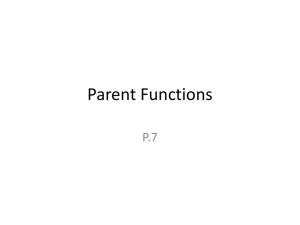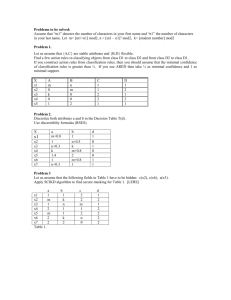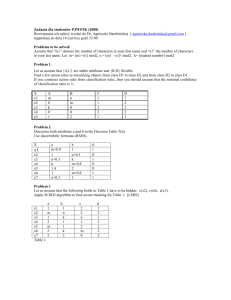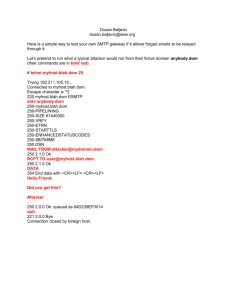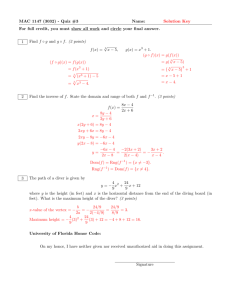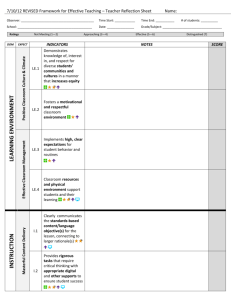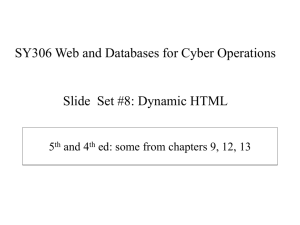SPECTRAL THEORY OF TRANSLATION SURFACES : A SHORT INTRODUCTION
advertisement
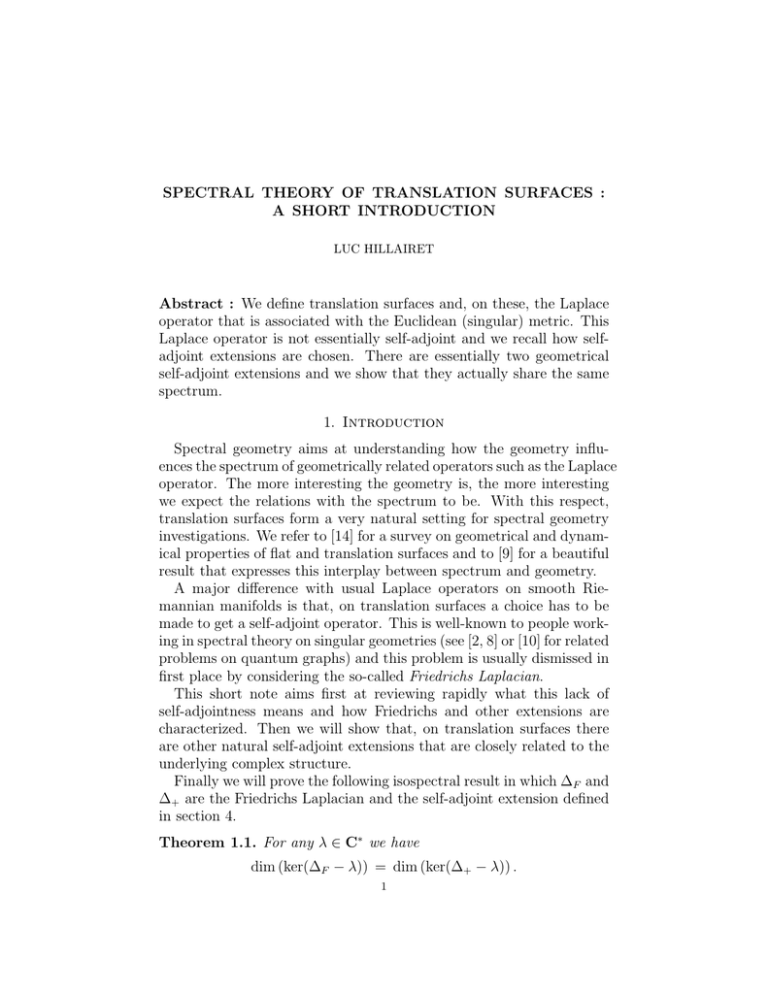
SPECTRAL THEORY OF TRANSLATION SURFACES :
A SHORT INTRODUCTION
LUC HILLAIRET
Abstract : We define translation surfaces and, on these, the Laplace
operator that is associated with the Euclidean (singular) metric. This
Laplace operator is not essentially self-adjoint and we recall how selfadjoint extensions are chosen. There are essentially two geometrical
self-adjoint extensions and we show that they actually share the same
spectrum.
1. Introduction
Spectral geometry aims at understanding how the geometry influences the spectrum of geometrically related operators such as the Laplace
operator. The more interesting the geometry is, the more interesting
we expect the relations with the spectrum to be. With this respect,
translation surfaces form a very natural setting for spectral geometry
investigations. We refer to [14] for a survey on geometrical and dynamical properties of flat and translation surfaces and to [9] for a beautiful
result that expresses this interplay between spectrum and geometry.
A major difference with usual Laplace operators on smooth Riemannian manifolds is that, on translation surfaces a choice has to be
made to get a self-adjoint operator. This is well-known to people working in spectral theory on singular geometries (see [2, 8] or [10] for related
problems on quantum graphs) and this problem is usually dismissed in
first place by considering the so-called Friedrichs Laplacian.
This short note aims first at reviewing rapidly what this lack of
self-adjointness means and how Friedrichs and other extensions are
characterized. Then we will show that, on translation surfaces there
are other natural self-adjoint extensions that are closely related to the
underlying complex structure.
Finally we will prove the following isospectral result in which ∆F and
∆+ are the Friedrichs Laplacian and the self-adjoint extension defined
in section 4.
Theorem 1.1. For any λ ∈ C∗ we have
dim (ker(∆F − λ)) = dim (ker(∆+ − λ)) .
1
2
L. HILLAIRET
2. Translation surfaces
We will implicitly assume that all our surfaces are compact. We refer
to [14] for a much more complete presentation of translation surfaces.
There are several ways of defining a translation surface. A very concrete one is to consider a polygon in R2 (not necessarily connected) with
an even number of sides that can be identified pairwise by translation.
A translation surface is then obtained by making these identifications.
This surface comes naturally equipped with a Euclidean metric that
is defined everywhere except at the points that correspond to identified
vertices of the original polygon.
Denote by p one of these points. Near p the surface is obtained by
gluing together several Euclidean triangles with vertex p. This makes
X locally isometric to a neighbourhood of the tip of a Euclidean cone
of some angle αp .
Since all the identifications are by translation and the original polygon has trivial holonomy, it follows that the surface also has trivial
holonomy so that the angles of the conical points necessarily are multiples of 2π. When the conical angle is exactly 2π, the flat metric can
be smoothly extended to p.
Notation 2.1. We denote by P the set of conical points with angle
different than 2π and set X0 = X\P. At a singularity p we will denote
the total angle of the conical singularity by αp and by kp the integer
such that αp = 2(kp + 1)π. Near a conical point p, we will use polar
coordinates (r, θ) ∈ (0, r0 ) × R/αp Z where r0 is small enough so that
{r ≤ r0 } with the metric dr2 + r2 dθ2 embeds isometrically into X.
A surface X than can be written X = X0 ∪ P and endowed with
a (singular) metric that is Euclidean on X0 and locally isometric to
a neighbourhood of the tip of a Euclidean cone near each point of P
is called a Euclidean surface with conical singularities (E.C.S.C.) (see
[13, 8]). An alternative definition is to say that a translation surface
is a E.C.S.C. that has trivial holonomy. Observe however that the
condition to have trivial holonomy is strictly more restrictive than just
asking that the conical points have angle that are multiples of 2π.
Another way of defining a translation surface is by starting from a
Riemann surface X and by choosing a holomorphic one form ω. Near
points where ω doesn’t vanish it is possible to find a local holomorphic
coordinate such that ω = dz Near a zero of order k, one can find a
local coordinate so that ω = (k + 1)ζ k dζ. In both cases, we call such a
local coordinate a local distinguished (holomorphic) coordinate.
TRANSLATION SURFACES
3
We denote by P the set of zeros of ω and by X0 := X\P and we
observe that the metric |ω|2 is flat with conical singularities thus giving
M the structure of a E.S.C.S.. On X0 the set of local distinguished
coordinates provides us with an atlas whose transition functions are (by
definition) translations so that the holonomy is trivial and X indeed is
a translation surface.
Remark 2.2. The flat metric with conical singularity defines ω only up
to phase factor (since exp(iθ)ω defines the same metric as ω).
3. The Laplace operator on a translation surface
3.1. The Friedrichs extension. In this section we actually do not
use the fact that we are dealing with a translation surface. Everything
we will say actually holds true on a general E.S.C.S. We refer to [8, 5] for
a more complete treatment of self-adjoint extensions of the flat Laplace
operator on a E.C.S.C.. The reader who is not familiar with operators
and quadratic forms with domain as well as with Von Neumann theory
of self-adjoint extensions will find in [12, 11, 1] (among several other
good books) good references on these topics.
Notation 3.1.
1- The translation surface X comes naturally equipped with a
Euclidean metric with conical singularities. We denote by dx
the Euclidean area element that is associated with it and by
L2 (X, dx) the associated Hilbert space of square-integrable functions. The scalar product on L2 (X, dx) is :
Z
hu, vi =
u(x)v(x) dx,
X
and k · k is the associated norm. Near conical points we have
dx = rdrdθ in the corresponding polar coordinates.
2- We denote by D(X) the set of smooth functions with support
in X0 .
3- We denote by ∇ the Euclidean gradient on X0 and by ∆ the
Euclidean Laplace operator on X0 . Both are well defined on
functions in D. The graph norm associated with ∆ is
∀u ∈ D, kuk2∆ = kuk2 + k∆uk2 .
4- We also define on D the following quadratic form (Dirichlet
energy form) :
Z
∀u ∈ D, q(u) =
|∇u|2 dx.
X
4
L. HILLAIRET
We will denote by q the polarization of q. The graph norm
associated with q is
∀u ∈ D, kuk2q = kuk2 + q(u).
A straightforward integration by parts proves that for any u, v ∈ D,
h∆u, vi = q(u, v) = hu, ∆vi.
This proves that ∆ is symmetric on the domain D and that q is the
quadratic form associated with ∆. It follows that ∆ and q are closable.
We will still denote by ∆ and q the operator obtained by taking the
closure. By definition we thus have that dom(∆) is the closure of D
with respect to k · k∆ and that dom(q) is the closure of D with respect
to k · kq .
We will denote by ∆F the unique self-adjoint operator that is associated with the closed quadratic form q. Of course, ∆F is a self-adjoint
extension of ∆ which is known as the Friedrichs extension (compare
the construction with theorem X.23 of [11]).
We define the scale of Sobolev spaces associated
with the non-negative
s
s
2
operator ∆F . We set H (X) := dom(∆F ). With this definition we have
(1)
H 1 (X) = dom(q).
Since the surface X is compact then a Rellich-type theorem (see [2]
for instance) implies that ∆F has compact resolvent. The spectrum of
∆F thus consists only of eigenvalues of finite multiplicity.
3.2. Von Neumann theory. We recall the following formulation of
Von Neumann’s classification of self-adjoint extensions.
Let H be a Hilbert space and A be an unbounded symmetric operator. Define the sequilinear form G on dom(A∗ ) by
(2)
G(u, v) = hA∗ u, vi − hu, A∗ vi .
Since A is symmetric, dom(A) is a closed subspace of dom(A∗ ). Let
π be the canonical projection from dom(A∗ ) onto dom(A∗ )/dom(A).
For any u and v in dom(A∗ ), G(u, v) = 0. The form G thus descends
as a sesquilinear form on dom(A∗ )/dom(A).
For any closed subspace L in dom(A∗ )/dom(A) we define AL to be
∗
A restricted to π −1 (L). By symmetry AL always extends A and any
extension of A can be written as an AL . The following theorem classifies
the self-adjoint extensions of A.
Theorem 3.2. The sesquilinear form G defines a hermitian symplectic
form on dom(A∗ )/dom(A) and AL is self-adjoint if and only if L is a
lagrangian subspace for G.
TRANSLATION SURFACES
5
3.3. The domain of ∆∗ . It turns out that the presence of conical
singularities prevents ∆ from being essentially self-adjoint on the domain D so that other self-adjoint extensions than ∆F may be considered. Since Von Neumann theory relies on an explicit description
of dom(∆∗ )/dom(∆), we first describe the behaviour of elements of
dom(∆∗ ) near the conical points. In order to do so, we introduce the
following functions :
Notation 3.3. For each conical point p of angle αp we choose a cut-off
function ρp (r) that is identically 1 if r is small enough and identically
0 if r ≥ r0 and we define the following functions, for any l ∈ Z,
F0+ (r, θ) = ρp (r)
F0− (r, θ), = log(r)ρp (r)
− 12 2|l|π
+
Fp,l
θ) l 6= 0
(r, θ) = 2|l|π
r αp ρp (r) exp( 2ilπ
αp
αp
− 12 2|l|π
−
−
Fp,l
(r, θ) = 2|l|π
r αp ρp (r) exp( 2ilπ
θ) l =
6 0
αp
αp
+
Remark 3.4. By inspection, we see that Fp,l
always belong to L2 (X, dx)
−
< 1.
whereas Fp,l
belongs to L2 (X, dx) if and only if 2|l|π
αp
Of course, if αp = 2(k + 1)π the expressions can be written in a simpler way but we want to emphasize here that the following proposition
is true on any E.C.S.C..
Proposition 3.5. For any p ∈ P , define Np to be the greatest integer N
such that N < α2πp + 1. Let u ∈ dom(∆∗ ) then there exists u0 ∈ dom(∆)
and, for any conical point p, there exists a collection (a±
p,l )−Np ≤l≤Np such
that the following holds.
(3)
u = u0 +
X l=N
Xp
+
−
−
a+
p,l Fp,l + ap,l Fp,l .
p∈P l=−NP
Proof.
P The proof relies on the following facts. First the function w :=
(1 − p ρp )u lives on the surface Xε where we have cut out a small ball
of radius ε near each conical point. We can see, by inspection that w
actually is in the domain of the Dirichlet flat Laplacian on Xε . It follows
that w is in dom(∆) on X. It remains to study each vp := ρp u. Each of
these function may be seen as living on the infinite cone of angle αp .
As such it is a function of dom(∆∗p ) where we have denoted by ∆p the
flat laplacian on the infinite cone. Separating variables, we are led to
study the following one dimensional operators on the half-line :
1
ν2
Pν (u) = − (ru0 )0 + 2 u,
r
r
6
L. HILLAIRET
where ν = 2lπ
and the reference Hilbert space is L2 ((0, ∞), rdr). These
αp
operators are essentially selfadjoint if ν 2 ≥ 1 so that the sum over the
corresponding modes actually is in dom(∆). For the remaining modes,
using Bessel functions we derive the given asymptotic expansion. (See
also the appendix to section X.1 of [11])
P
We set N = p∈P 2Np + 1 and we order the conical points and define A± (u) to be the vector of CN collecting all the coefficients a±
p,l by
putting first all the coefficients corresponding to p1 then those corresponding to p2 etc... We thus define a linear isomorphism A = (A+ , A− )
from dom(∆∗ )/dom(∆) onto CN × CN .
On CN we define the canonical scalar product h·, ·i; and on CN ×CN ,
the canonical hermitian symplectic form Ω by
Ω((A+ , A− ), (B + , B − )) = hA+ , B − i − hA− , B + i.
We then obtain.
Proposition 3.6. For any two elements u, v in dom(∆∗ )/dom(∆), we
have
G(u, v) = −2 · Ω(A ◦ πu, A ◦ πv).
For any subspace L ⊂ CN × CN which is lagrangian with respect to Ω
∆∗ restricted to (A ◦ π)−1 (L) is a self-adjoint extension of ∆ that we
denote ∆L .
Proof. For u and v in dom(∆∗ ), write u = us + u0 (resp. v = vs + v0 )
where u0 is the function defined in proposition 3.5 and us := u − u0 is
the singular part. By symmetry of ∆, we have
G(u, v) = G(us , vs ),
and the latter is computed directly using the followings integrals :
Z ∞
0
1
1
0 −ν
µ 0
µ
−ν 0
Iµ,ν =
(r(r ρ (r)) r ρ(r) − r ρ(r) r(r ρ (r) rdr.
r
r
0
When |µ|, |ν| < 1 these integrals are finite and vanish except if µ = ν
for which we have Iνν = −2ν. The remaining statement is a direct
application of theorem 3.2
We can now identify the lagrangian subspace LF corresponding to
the Friedrichs extension.
Proposition 3.7. We have
LF = {(A+ , A− ) | A− = 0}.
TRANSLATION SURFACES
7
Proof. Since dom(∆F ) ⊂ dom(q), all the elements of dom(∆F ) must
have a gradient which is square-integrable. This implies that all the
coefficients a−
p,l vanish. Since this defines a lagrangian subspace we
have the proposition. (Compare with the definition of [2] using Hankel
tranform).
As we have already said, everything in this section applies equally
well to E.S.C.S. . In the next section we prove that, on translation
surfaces there are two other natural self-adjoint extensions.
4. Cauchy-Riemann operators and DtN-Isospectrality
Since the holonomy is trivial on a translation surface, we can define
directions in a consistent way. Choosing two orthonormal directions,
we can define two operators ∂x and ∂y that are perfectly well-defined
on functions of D. We normalize these operators in such a way that
there exists a coordinate patch on which ω = dx + idy and dx(∂x ) = 1
and dy(∂y ).
Using this we define the operators D± on D by :
(4)
D+ = i∂x + ∂y = 2i∂z ,
(5)
D− = i∂x − ∂y = 2i∂z̄ .
For u ∈ D we have kD± uk2 = q(u) so that D± are closable and the
domain of the closure is dom(q) = H 1 (X).
Remark 4.1. It should be pointed out that the existence of conical
points implies that these operators do not commute with ∆F (as it
would be the case in the plane or on a torus). This implies that the
spectrum of a translation surface cannot be computed by separating
variables. It also implies that there is some function u in dom(∆F )
such that ∂x2 (in the distributional sense) isn’t L2 . In [4] the discrepancy between Sobolev spaces associated to the Friedrichs extension and
Sobolev spaces defined by iterated regularity is studied in much greater
detail.
Since for u ∈ D we have
∗
D±
D± u = D∓ D± u = ∆u,
∗
u = D± D∓ u = ∆u,
D± D±
we obtain four natural reasonable self-adjoint extension of ∆.
The following lemma actually says that two of these are the Friedrichs
extension.
8
L. HILLAIRET
Lemma 4.2. We have
∗
D±
D± = ∆F .
∗
Proof. This follows from the fact that dom(D±
D± ) ⊂ dom(D± ) =
1
H (X), and the Friedrichs extension is the only extension of ∆ whose
domain is a subset of H 1 (X).
∗
Notation 4.3. We set D± D±
:= ∆± and define L± to be the corresponding lagrangian subspaces of CN × CN .
Remark 4.4. Using (4) and (5), we see that if F is L2 and holomorphic
∗
∗
∗
in X0 , then f ∈ dom(D−
) and D−
f = 0. The same is true for D+
and
2
antiholomorphic L functions. (See also [4])
We can also remark, that in
have
+
Fp,l (r, θ)
F − (r, θ)
p,l
(6)
−
F
p,l (r, θ)
+
Fp,l (r, θ)
the ball centered at p of radius ε we
l
= c+
p,l ζ
l > 0,
=
=
l > 0,
l < 0,
=
−l
c−
p,l ζ
l
c−
p,l ζ
−l
c+
p,l ζ
l < 0;
where the c±
p,l are normalizing constants.
This allows to prove the following proposition.
Proposition 4.5. An element u ∈ dom(∆∗ ) belongs to dom(∆− ) if
and only if
−
ap,l = 0 if l ≥ 0
(7)
a+
p,l = 0 if l < 0.
An element u ∈ dom(∆∗ ) belongs to dom(∆+ ) if and only if u ∈
dom(∆− ), or, alternatively, if the following set of conditions is satisfied :
−
ap,l = 0 if l ≤ 0
(8)
a+
p,l = 0 if l > 0.
Proof. Using remark 4.4, we see that if u is holomorphic near p then
it belongs to dom(∆− ). This implies that if the coefficients of ζ̄ l in
the expansion (3) vanish then u ∈ dom(∆+ ). Comparing with (6), it
gives the inclusion of dom(∆− ) into the set defined by the equations
(7). Since both these subspaces are lagrangian we obtain the equality.
The same reasoning with antiholomorphic functions yields the result
for ∆+ .
Corollary 4.6. The operators ∆+ and ∆− are isospectral.
TRANSLATION SURFACES
9
Proof. Indeed, the complex conjugation is invertible and intertwins
both operators.
4.1. DtN Isospectrality and commutators. In this last section we
will derive two applications using these operators ∆+ . The first one is
some kind of isospectrality that we define now.
Definition 4.7 (Dirichlet-to-Neumann isospectrality). Let A1 and A2
be two self-adjoint operators with compact resolvent such that
(1) A1 and A2 are two self-adjoint extensions of the same operator
A0 .
(2) For any λ 6= 0, the eigenspaces ker(A1 − λ) and ker(A2 − λ)
have the same dimension.
Then we will say that A1 and A2 are Dirichlet-to-Neumann isospectral.
(DtN-isospectral).
There are several examples in the literature of DtN-isospectrality
and sometimes the condition λ 6= 0 may even be dropped.
1- The operators u 7→ −u00 on [0, 1] with Dirichlet and Neumann
boundary condition are DtN-isospectral.
2- So are the examples of domains with mixed Dirichlet-Neumann
boundary condition of [7].
3- And so are operators in the class ON of [6] that correspond to
the same representation (see proposition 2 of [6]).
We have the following theorem.
Theorem 4.8. The operators ∆F and ∆+ are DtN-isospectral.
Proof. It is actually a general fact that AB and BA have the same nonzero spectrum. The proof runs as follows. Let u 6= 0 be an element of
ker(∆F − λ) then u is characterized by ∆∗ u = λu and u ∈ dom(∆F ).
Since dom(∆F ) ⊂ H 1 (X) we can apply D+ to u and compute ∆∗ D+ u.
For any test function φ ∈ D we have
hD+ u, ∆φi =
=
=
=
=
hu, D− ∆φi
hu, ∆D− φi
h∆F u, D− φi
λhu, D− φi
λhD+ u, φi.
Thus we have ∆∗ D+ u = λD+ u. It remains to show that D+ u belongs
to dom(∆+ ). This can be seen directly by considering the action of D+
on the functions Fp,l or using a more abstract argument. Since λ 6= 0
D+ u 6= 0 so that we have an injective linear map from ker(∆F − λ) into
10
L. HILLAIRET
∗
ker(∆+ − λ). The same reasoning proves that D+
defines an injective
linear map in the other direction. This yields the result.
The second application is concerned with commutation of ∆F and
D± . As it has already been pointed out, one should take care that, on
a translation surface that isn’t a torus, the operators ∂x and ∂y do not
commute. Neither do ∆F and D± commute. The following proposition
points out the fact that the lack of commutation can be described by
a finite rank operator.
We introduce the family of operators K(λ) such that
(∆+ − λ)−1 = (I + K(λ)) (∆F − λ)−1
This construction is standard in perturbation theory. In the case of
changing the self-adjoint condition it is closely related to the Dirichletto-Neumann operator. In our case, since dom(∆∗ )/dom(∆) is finitedimensional the family K(λ) is finite rank. (See also [3, 5]).
Proposition 4.9. For any λ in the resolvent set of ∆F , and for any
f ∈ H 1 (X) we have
D+ , (∆F − λ)−1 f = K(λ) (∆F − λ)−1 D+ f.
Proof. Denote by uF the solution to
(∆F − λ) uF = f.
We apply D+ to both sides of the equation. The proof of Theorem 4.8
implies the following commutation property
D+ (∆F − λ) uF = (∆+ − λ) D+ uF .
We thus obtain
D+ (∆F − λ)−1 f = (∆+ − λ)−1 D+ f.
The claim follows by replacing the resolvent of ∆+ using the definition
of K(λ).
References
[1]
[2]
[3]
[4]
M. Sh. Birman and M. Z. Solomjak. Spectral theory of selfadjoint operators in Hilbert space. Mathematics and its Applications (Soviet Series).
D. Reidel Publishing Co., Dordrecht, 1987. Translated from the 1980
Russian original by S. Khrushchëv and V. Peller.
J. Cheeger and M. Taylor. On the diffraction of waves by conical singularities. I. Comm. Pure Appl. Math., 35(3):275–331, 1982.
G. Grubb. Distributions and operators, volume 252 of Graduate Texts in
Mathematics. Springer, New York, 2009.
G. Forni. Sobolev regularity of solutions of the cohomological equation,
preprint, http://arxiv.org/abs/0707.0940v2, 2007.
TRANSLATION SURFACES
11
[5]
L. Hillairet and A. Kokotov. S-matrix and Krein formula on Euclidean
surfaces with conical singularities. In preparation, 2010.
[6]
L. Hillairet. Spectral decomposition of square-tiled surfaces. Math. Z.,
260(2):393–408, 2008.
[7]
D. Jakobson, M. Levitin, N. Nadirashvili, and I. Polterovich. Spectral
problems with mixed Dirichlet-Neumann boundary conditions: isospectrality and beyond. J. Comput. Appl. Math., 194(1):141–155, 2006.
[8]
A. Kokotov. Compact polyhedral surfaces of an arbitrary genus and
determinants of Laplacians, preprint, http://arxiv.org/abs/0906.0717v1,
2009.
[9]
A. Kokotov and D. Korotkin. Tau-functions on spaces of abelian differentials and higher genus generalizations of Ray-Singer formula. J. Differential Geom., 82(1):35–100, 2009.
[10]
V. Kostrykin and R. Schrader. Laplacians on metric graphs: eigenvalues, resolvents and semigroups. In Quantum graphs and their applications, volume 415 of Contemp. Math., pages 201–225. Amer. Math. Soc.,
Providence, RI, 2006.
[11]
M. Reed and B. Simon. Methods of modern mathematical physics. II.
Fourier analysis, self-adjointness. Academic Press [Harcourt Brace Jovanovich Publishers], New York, 1975.
[12]
M. Reed and B. Simon. Methods of modern mathematical physics. I.
Academic Press Inc. [Harcourt Brace Jovanovich Publishers], New York,
second edition, 1980. Functional analysis.
[13]
M. Troyanov. Les surfaces euclidiennes à singularités coniques. Enseign.
Math. (2), 32(1-2):79–94, 1986.
[14]
A. Zorich. Flat surfaces. In Frontiers in number theory, physics, and
geometry. I, pages 437–583. Springer, Berlin, 2006.
E-mail address: Luc.Hillairet@math.univ-nantes.fr
UMR CNRS 6629-Université de Nantes, 2 rue de la Houssinière,, BP
92 208, F-44 322 Nantes Cedex 3, France
